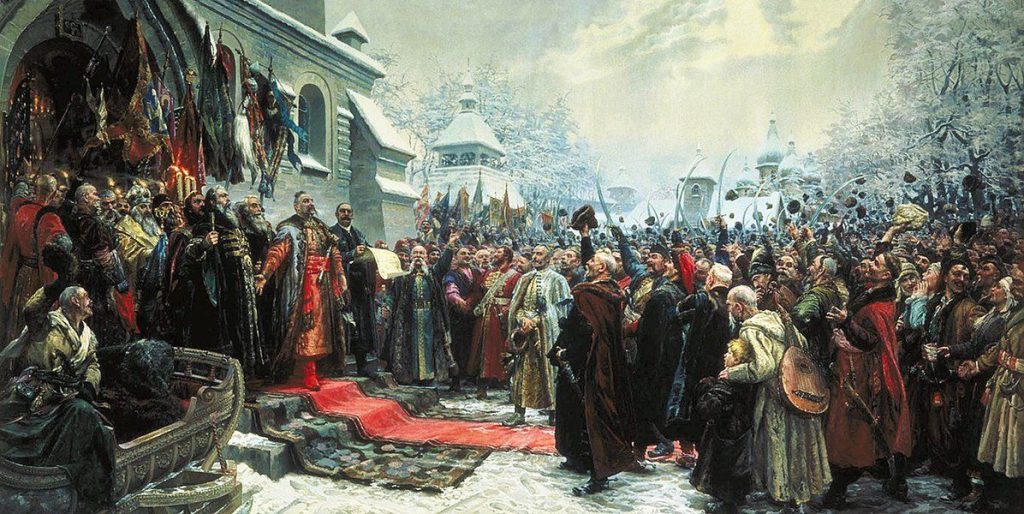In late April 2024, a sculpture in central Kyiv that commemorated the 17th-century Pereiaslav Treaty between the Cossacks and Muscovites was dismantled, symbolically closing a chapter of shared history between Ukraine and Russia. The treaty, signed in 1654, was seen by Russian President Vladimir Putin as evidence of Ukraine’s historical subservience to Moscow. However, Ukrainian historian Serhii Plokhy views the treaty as the beginning of a shared history between Ukrainians and Russians, rather than a unification of one “Rus nation.” The treaty had a different legacy for both nations, as it eventually led to Ukraine’s subjugation by Moscow, culminating in the dissolution of the hetmanate a century later.
The world in which the Pereiaslav Treaty was born saw the Cossacks, a largely Orthodox group from the Ukrainian steppe, rebelling against their Catholic rulers in the Polish-Lithuanian Commonwealth. Seeking allies, the Cossacks turned to Moscow for aid, citing shared Orthodox faith and historical legacy. A council was convened in Pereiaslav in 1654, where the Cossacks pledged allegiance to the Muscovite Tsar. However, the treaty’s outcome revealed a cultural and political divide between the Cossacks and the Muscovites, with Moscow eventually betraying the Cossacks and signing a separate peace deal with Poland.
Putin’s narrative of the Pereiaslav Treaty as a symbol of unity between Russians and Ukrainians has been used to justify Russia’s invasion of Ukraine. Putin’s assertion that the Cossacks referred to themselves as “Russian Orthodox” is based on Soviet and imperial narratives that sought to subjugate Ukraine for centuries. The post-Soviet era continued to propagate this narrative of Russo-Ukrainian unity, with monuments and celebrations honoring the Pereiaslav Council. However, the dismantling of these monuments in 2024 marked a departure from the Kremlin-established narrative, signaling a rejection of the historical revisionism that sought to erase Ukrainian identity.
The Pereiaslav Council’s significance lies in its divergence in interpretations by Russia and Ukraine, shaping the course of their historical relationship. While Russia viewed the treaty as a reaffirmation of its imperialist claims over Ukraine, Ukraine saw it as the beginning of a painful subjugation by Moscow. The dissolution of the hetmanate and the gradual erosion of Ukrainian rights by Moscow underscored the impact of the Pereiaslav Treaty on Ukrainian history. The manipulation of historical narratives by Russia, as seen in Putin’s justification for the invasion, highlights the ongoing struggle for Ukrainian sovereignty and independence.
The legacy of the Pereiaslav Treaty underscores the complexities of Russo-Ukrainian relations and the divergent paths taken by both nations following the treaty. The shared history of the Kyivan Rus civilization gave way to distinct political, cultural, and linguistic developments in Ukraine and Russia. The treaty, once seen as a symbol of unity, ultimately became a tool for Moscow to exert control and dominance over Ukraine. The dismantling of monuments and narratives associated with the Pereiaslav Council represents a rejection of historical revisionism and a reaffirmation of Ukrainian identity and sovereignty in the face of Russian aggression.
In conclusion, the dismantling of the Pereiaslav Treaty monument in Kyiv signifies a rejection of historical revisionism and a reaffirmation of Ukrainian identity and sovereignty. The divergent interpretations of the treaty by Russia and Ukraine highlight the complexities of their historical relationship. The legacy of the treaty, once seen as a symbol of unity, ultimately became a tool for Russian dominance over Ukraine. The ongoing struggle for Ukrainian independence is underscored by the manipulation of historical narratives by Russia, as seen in Putin’s justification for the invasion. The dismantling of monuments associated with the Pereiaslav Council marks a pivotal moment in Ukraine’s fight for autonomy and self-determination.


